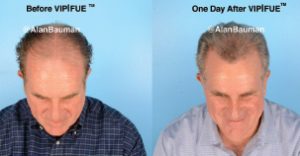By Alan J Bauman, MD, ABHRS
Board-Certified Hair Restoration Physician

Having been in the hair restoration field for almost 25 years, I’ve heard just about all of the misconceptions anyone has ever come up with about hair loss and hair restoration.
With August being Hair Loss Awareness Month, it had me thinking that it might be interesting – and entertaining – to throw out a few fun facts to test your knowledge about what is – and isn’t – the truth about hair loss.
One of my favorite baldness “remedies” was created by Hippocrates, the “Father of Modern Medicine,” whose topical remedy consisted of a concoction of opium, horseradish, pigeon droppings, beetroot, and spices. At least Julius Caesar resorted to a laurel wreath instead of a combover!
So, let me ask you, which of these hair loss “causes” is a fact?
Wearing a hat
Only your mother’s genes (not your father’s, too)
Frequent hair washing
Too much testosterone
Clogged pores on the scalp
If you said “none,” you’re right.
Wearing a hat doesn’t cause hair to fall out, despite what pilots tell you.
You can inherit hair loss genes from both parents.
Frequently washing your hair isn’t the problem. Rigorous towel drying or too-hot hair dryers can be.
This one’s tricky because it’s not necessarily the amount of testosterone you have that contributes to hair loss. It’s the way any given individual’s body reacts to testosterone and its metabolites that can cause it in some people (and that’s genetic).
Clogged pores cause acne, not hair loss.
Regardless of your actual – and true – cause of hair loss, sometimes it’s gone too far for remediation with therapies such as topical treatments. That’s when hair transplants, with their extraordinary technological advancements, can enter the mix. However, many people hesitate because they harbor an outdated understanding of the facts. Here are a few of the most common misconceptions.
A hair transplant will look “pluggy”
The truth is, pluggy results were very common decades ago. However, significant innovations in microsurgery techniques, when performed by a skilled, artistic transplant surgeon, result in a 100% natural look. Advanced, minimally invasive hair transplant procedures using follicular unit extraction (FUE) meticulously move as little as one hair follicle at a time. This fine control of individual hair position and direction eliminates “plugs” or “rows” as well as the telltale linear scars left by the old “strip harvest” methods.
Even with newer techniques, my hair will have to be shaved or cut, and everyone will be able to tell I’ve had a hair transplant
Wrong again. The newest No-Shave Long-Hair VIP|FUE™ technique harvests hair without any hair trimming whatsoever. The donor area remains completely hidden amidst the surrounding full-length hair, and no dramatic shave or trim is required around the sides and back of the scalp. Minimally-invasive VIP|FUE™requires no staples or stitches and leaves no linear scar.
A hair transplant is painful during and after the procedure
Definitely not! Local anesthesia and medication for relaxation allow patients to sit, watch movies, listen to music or even comfortably nap during their procedure.
Even injecting the anesthesia is now pain-free. Our new computerized local anesthesia delivery system uses a microprocessor-controlled, robotic injection technique using extremely low pressure and a slow rate of flow for a completely pain-free injection.
Our new advanced FUE transplant harvest techniques also allow for a faster, easier recovery because hair follicles are harvested individually with minimal tension on the skin. Most patients can resume regular activities immediately and get back in the gym within just a few days following a hair transplant.
Doctors who perform hair transplants have special training and credentials
Not necessarily. MDs and DOs are allowed by law to perform surgery, including hair transplantation, but this doesn’t mean they possess a high level of skill or training in this specialty area.
A significant issue in the hair transplant field today is that many unqualified, inexperienced non-specialist physicians offer this procedure, which they perform infrequently. Your surgeon’s experience, knowledge and artistry are of utmost importance to ensure the most natural looking result. (See sidebar for tips on how to choose a hair transplant surgeon).
Tips on Finding a Top Hair Restoration Physician
A hair restoration physician is someone who specializes exclusively in the medical diagnosis, treatment, and tracking of hair loss and hair growth.
Look for a full-time hair transplant surgeon who is certified by the American Board of Hair Restoration Surgery (ABHRS) and accepted by the International Alliance of Hair Restoration Surgeons (IAHRS).
Due to the limited number of full-time, experienced ABHRS-certified hair restoration physicians worldwide, prospective patients should be prepared to travel and/or consult “virtually” via phone, Zoom or other videoconferencing services.
Before choosing your doctor, research the clinic, read reviews and request before-and-after pictures. Ask questions about how to achieve your desired results and what should be done to maintain them.
The International Society of Hair Restoration Surgery (ISHRS) urges patients to avoid unprofessional clinics and unscrupulous practices that offer unsolicited financial incentives upfront. Ask yourself if a practice offering “free consultations,” deeply discounted coupons, or financial rebates truly has your best interests in mind.
Bauman Medical
Hair Restoration for Men and Women
www.baumanmedical.com
561-220-3480
 Central Florida Health and Wellness Magazine Health and Wellness Articles of the Villages
Central Florida Health and Wellness Magazine Health and Wellness Articles of the Villages



